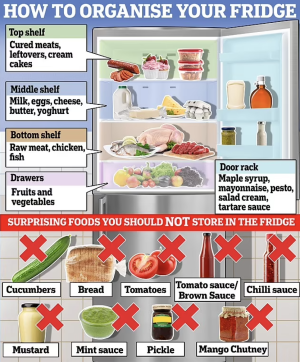Experts Shocked: The Ultimate Fridge Organisation Guide is Here – Find Out Where You've Been Going Wrong and Where to Really Put Your Tomato Sauce!
By
Seia Ibanez
- Replies 33
The humble refrigerator: a modern marvel that keeps our food fresh and our drinks chilled. But did you know that the way you organize your fridge can impact not just the longevity of your food, but also your health? It's true, and experts have weighed in to finally put to rest the age-old debate on where to store tomato sauce and how to properly organize every single item in your fridge.
At the Seniors Discount Club, we understand that keeping a well-organized fridge is more than just a matter of neatness; it's about making the most of our groceries and ensuring we're eating the freshest, safest food possible. So, let's dive into the expert advice and learn how to master the art of fridge organization.
**The Correct Spot for Every Single Item**
You might think that tossing your groceries into the fridge wherever there's space is good enough, but there's actually a science to the layout. The temperature in your fridge isn't uniform; it varies between shelves. The top shelf tends to be warmer, while the bottom is cooler. Here's how to use this to your advantage:
- **Top Shelf:** Reserve this space for cured meats, leftovers, cream cakes, and other ready-to-eat items. These foods don't require cooking, which means they're less likely to contaminate other foods if they're stored higher up.
- **Middle Shelf:** This is the prime real estate for dairy products like cheese, butter, and yogurt, as well as eggs. Surprisingly, milk should also live here instead of the fridge door, as it's a perishable item that benefits from a consistent, cool temperature.
- **Bottom Shelf:** Raw meat, poultry, and seafood should be placed here. It's the coldest part of the fridge, which is essential for slowing down bacterial growth. Always store these items in sealed containers to prevent any juices from contaminating other foods.
- **Drawers:** Fruits and vegetables should be stored in separate drawers, as some fruits emit ethylene gas, which can cause vegetables to spoil faster.
**The Great Tomato Sauce Debate**
Now, let's settle the tomato sauce conundrum once and for all. According to experts, tomato sauce doesn't need to be refrigerated thanks to its vinegar content and the natural acidity of tomatoes. This means it's perfectly fine to store it in the cupboard along with other condiments like brown sauce, mustard, and pickles. However, if you prefer your tomato sauce chilled, it won't harm it to keep it in the fridge.
**Surprising Foods That Shouldn't Be in the Fridge**
Some foods actually fare worse in the cold environment of a fridge. Bread, for example, can dry out and go stale faster. Cucumbers and tomatoes lose flavor and can become mushy. These items are better off in the pantry or on the counter.
**Optimal Fridge Temperature**
To ensure your food stays fresh and safe, keep your fridge temperature between 0°C and 5°C. Anything above 8°C enters the danger zone where harmful bacteria can thrive. A well-maintained temperature not only keeps your food safe but also maximizes nutrient retention.
**Final Thoughts**
Organizing your fridge correctly can make a significant difference in how long your food lasts and how safe it is to eat. It's worth taking the time to arrange your groceries properly and to adjust your fridge's temperature settings as needed. Remember, an organized fridge is a happy fridge, and a happy fridge means less waste, more savings, and better health.

So, dear members, how do you organize your fridge? Have you been keeping your tomato sauce in the fridge all this time? Share your fridge organization tips and tricks in the comments below, and let's keep the conversation going!
At the Seniors Discount Club, we understand that keeping a well-organized fridge is more than just a matter of neatness; it's about making the most of our groceries and ensuring we're eating the freshest, safest food possible. So, let's dive into the expert advice and learn how to master the art of fridge organization.
**The Correct Spot for Every Single Item**
You might think that tossing your groceries into the fridge wherever there's space is good enough, but there's actually a science to the layout. The temperature in your fridge isn't uniform; it varies between shelves. The top shelf tends to be warmer, while the bottom is cooler. Here's how to use this to your advantage:
- **Top Shelf:** Reserve this space for cured meats, leftovers, cream cakes, and other ready-to-eat items. These foods don't require cooking, which means they're less likely to contaminate other foods if they're stored higher up.
- **Middle Shelf:** This is the prime real estate for dairy products like cheese, butter, and yogurt, as well as eggs. Surprisingly, milk should also live here instead of the fridge door, as it's a perishable item that benefits from a consistent, cool temperature.
- **Bottom Shelf:** Raw meat, poultry, and seafood should be placed here. It's the coldest part of the fridge, which is essential for slowing down bacterial growth. Always store these items in sealed containers to prevent any juices from contaminating other foods.
- **Drawers:** Fruits and vegetables should be stored in separate drawers, as some fruits emit ethylene gas, which can cause vegetables to spoil faster.
**The Great Tomato Sauce Debate**
Now, let's settle the tomato sauce conundrum once and for all. According to experts, tomato sauce doesn't need to be refrigerated thanks to its vinegar content and the natural acidity of tomatoes. This means it's perfectly fine to store it in the cupboard along with other condiments like brown sauce, mustard, and pickles. However, if you prefer your tomato sauce chilled, it won't harm it to keep it in the fridge.
**Surprising Foods That Shouldn't Be in the Fridge**
Some foods actually fare worse in the cold environment of a fridge. Bread, for example, can dry out and go stale faster. Cucumbers and tomatoes lose flavor and can become mushy. These items are better off in the pantry or on the counter.
**Optimal Fridge Temperature**
To ensure your food stays fresh and safe, keep your fridge temperature between 0°C and 5°C. Anything above 8°C enters the danger zone where harmful bacteria can thrive. A well-maintained temperature not only keeps your food safe but also maximizes nutrient retention.
**Final Thoughts**
Organizing your fridge correctly can make a significant difference in how long your food lasts and how safe it is to eat. It's worth taking the time to arrange your groceries properly and to adjust your fridge's temperature settings as needed. Remember, an organized fridge is a happy fridge, and a happy fridge means less waste, more savings, and better health.
Key Takeaways
- Experts from Which? have advised on the correct way to organise every single item in your fridge for optimal food safety and longevity.
- The organisation of food includes storing cured meats, leftovers, and ready-to-eat items on the top shelf, dairy products and eggs on the middle shelf, and raw meat, poultry, and seafood on the bottom shelf in sealed containers.
- Certain foods and condiments, including bread, cucumbers, tomatoes, and tomato sauce, do not require refrigeration and are better stored in the cupboard to maintain flavour and freshness.
- It is essential to maintain your fridge's temperature between 0°C and 5°C to prevent harmful bacteria from growing on food and to maximise the nutrients and shelf life of the contents.
So, dear members, how do you organize your fridge? Have you been keeping your tomato sauce in the fridge all this time? Share your fridge organization tips and tricks in the comments below, and let's keep the conversation going!








